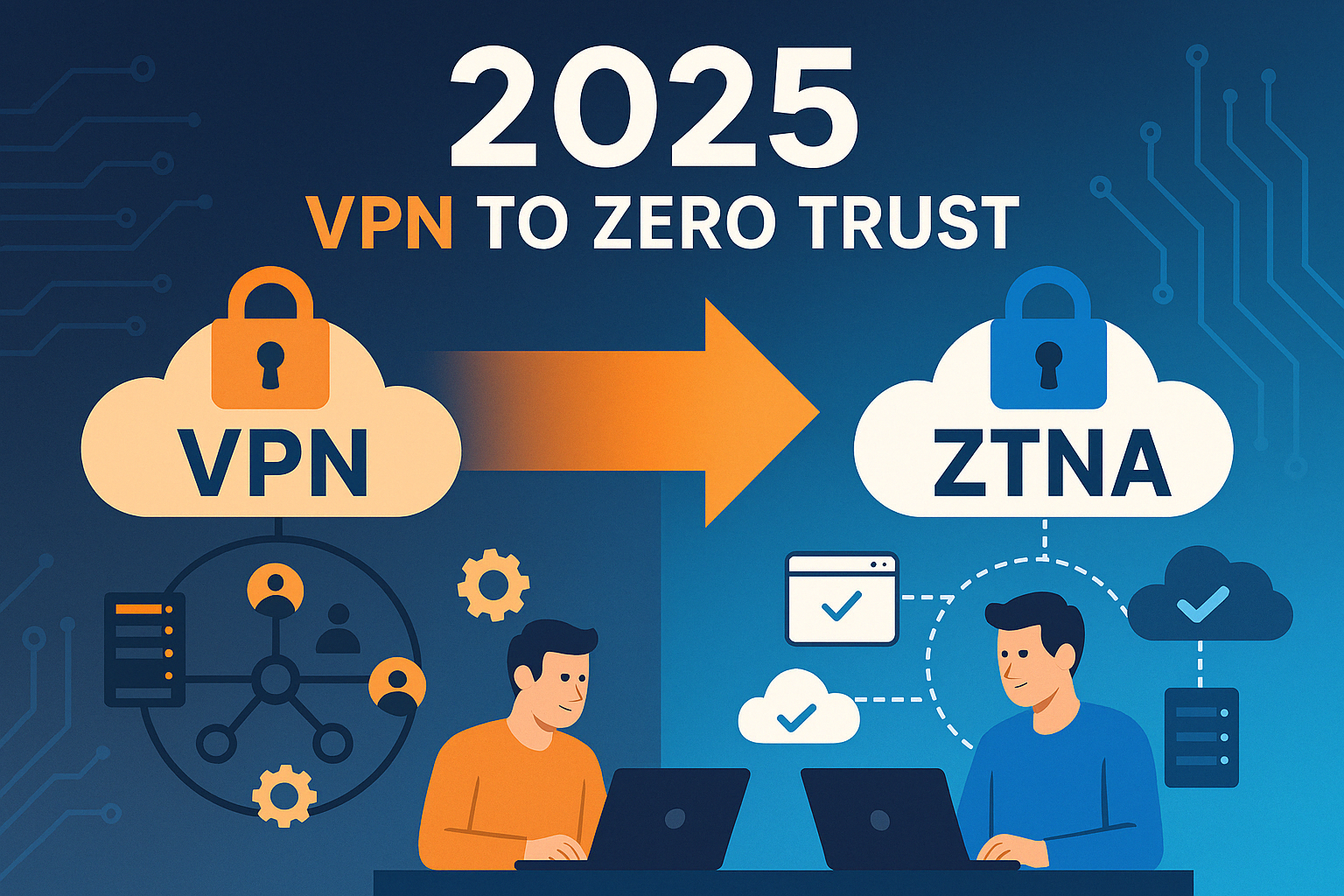
Introduction
The era of remote work is here to stay. As organizations expand their distributed workforce, securing remote access to corporate resources has become more critical — and more complex — than ever. In 2025, organizations must move beyond legacy VPNs and adopt a more holistic, zero trust and cloud-native approach. In this blog, we’ll explore how VPN, SASE (Secure Access Service Edge), ZTNA (Zero Trust Network Access), and related strategies converge to protect hybrid and remote workforces — and how your organization can transition effectively.
Why Traditional VPNs Are Reaching Their Limits
Virtual Private Networks (VPNs) have long been the backbone of remote access. They encrypt traffic from a remote user to a corporate network, making remote devices act as if they were on-premises. However, in today’s cloud-first, distributed environment, traditional VPNs show clear limitations:
-
Overbroad access & lateral movement risks: Once a user is inside via VPN, they often gain broad network access, increasing the attack surface. Reemo Blog+1
-
Performance bottlenecks: VPN traffic typically backhauls to centralized data centers, causing latency especially when remote users access SaaS or cloud-native apps. Work From Anywhere+2Palo Alto Networks+2
-
Scaling complexity & management overhead: Maintaining VPN concentrators, client software, patches, and configurations at scale is operationally heavy.
-
Exposed VPN gateways as targets: VPN endpoints become high-value targets for attackers, especially when vulnerabilities are found or credentials leaked.
-
Blind to modern threats & context: Traditional VPNs generally don’t integrate posture checks, device hygiene, continuous risk evaluation, or micro-segmentation.
Because of these shortcomings, many organizations are rethinking VPN as the default remote-access paradigm and adopting more adaptive, identity- and policy-driven alternatives. www.trendmicro.com+3Reemo Blog+3Work From Anywhere+3
Embracing Zero Trust & ZTNA
The fundamental shift replacing VPN in many architectures is the Zero Trust approach: “never trust by default, always verify” — regardless of user location or device. Zero Trust means continuous authentication and authorization, minimal necessary access, and granular controls.
Zero Trust Network Access (ZTNA) applies these principles to remote connectivity. Key characteristics:
-
Access is granted per-application or per-resource, not to the entire network.
-
Access policies consider user identity, device posture, time, location, behavior, and context.
-
The corporate network is never exposed directly; the remote user connects through a broker or proxy.
-
Access can be revoked dynamically if device posture changes or anomalies are detected.
This model dramatically reduces the attack surface and prevents lateral movement if a user or device is compromised. Zscaler+3Palo Alto Networks+3Reemo Blog+3
Benefits of ZTNA vs VPN:
| Factor | VPN | ZTNA / Zero Trust |
|---|---|---|
| Access scope | Network-level (often broad) | Application-level / resource-level |
| Implicit trust | Yes, once connected | No, each request re-evaluated |
| Exposure of network | Yes | Hidden / micro-segmented |
| Performance for cloud apps | May suffer | Optimized, direct access paths |
| Granularity & policy control | Limited | Fine-grained, contextual policies |
| Scalability & manageability | Complex | Cloud-native, easier scaling |
| Adaptability to hybrid / multi-cloud | Challenged | Designed for cloud/edge environments |
As organizations shift more workloads into cloud and SaaS, ZTNA becomes a foundational component of secure, adaptive remote access. Cybersecurity Insiders+4www.trendmicro.com+4Palo Alto Networks+4
SASE: The Unified Framework for Network + Security
While ZTNA handles access control, organizations often need more: secure web gateways, firewall services, data protection, traffic routing, and performance optimization. Enter SASE (Secure Access Service Edge) — a Gartner-coined architecture that converges networking and security into a cloud-delivered service. Cato Networks+4Reemo Blog+4Palo Alto Networks+4
Core elements of SASE:
-
SD-WAN: Software-defined routing that selects optimal paths for traffic.
-
FWaaS (Firewall as a Service): Cloud-native firewall functionality.
-
Secure Web Gateway (SWG): Inspect web traffic, block threats.
-
CASB (Cloud Access Security Broker): Govern traffic and usage of SaaS/cloud apps.
-
ZTNA: Application-level access control integrated into the stack.
-
Threat protection & data loss prevention: Inline monitoring, DPI, sandboxing.
By integrating all these in one cloud-native stack, SASE enables consistent security and performance regardless of user location or resource location. Palo Alto Networks+3Fortinet+3Cato Networks+3
Why SASE + ZTNA matters for remote work in 2025:
-
Unified policy enforcement: Same security policies apply across branch offices, cloud, and remote users.
-
Performance advantages: Remote users connect to the closest SASE node, not backhauling traffic to core data centers.
-
Reduced overhead: One platform replaces multiple disparate security tools.
-
Scalability & elasticity: Cloud-native model scales more easily as the workforce grows or shifts.
-
Better visibility & analytics: Centralized visibility across the network, endpoints, and cloud.
Many organizations now evaluate only SASE platforms that include ZTNA rather than stand-alone VPN or point solutions. Fortinet+3Reemo Blog+3Cybersecurity Insiders+3

Remote-Work Strategies & Best Practices in 2025
Moving from VPN to a SASE + ZTNA architecture is non-trivial. Below are practical strategies and best practices to build a secure, performant remote workforce.
1. Define your security foundations: identity, devices, posture
-
Deploy multi-factor authentication (MFA) universally (especially for remote access).
-
Use strong identity providers (IdP) and Single Sign-On (SSO).
-
Maintain an up-to-date inventory of users, devices, applications, and trust zones.
-
Enforce endpoint posture checks (OS version, patch status, antivirus, encryption).
-
Consider device attestation or endpoint agent enforcement.
2. Segment & prioritize applications
-
Begin with high-value, sensitive applications (e.g. finance, HR, IP).
-
Wrap them behind ZTNA access first, leaving less sensitive ones on traditional paths momentarily.
-
Use micro-segmentation and zero-trust zones to limit lateral movement.
3. Phased deployment & pilot testing
-
Start with a pilot group or department to test user experience, latency, and policy logic.
-
Operate in hybrid mode: legacy VPN + ZTNA coexist during transition.
-
Monitor performance, logs, and user feedback before full rollout.
4. Integrate analytics, monitoring & incident response
-
Enable continuous monitoring and behavioral analytics on remote access.
-
Use SIEM, XDR tools to detect anomalies (unauthorized access, policy violations).
-
Automate responses (disconnect sessions, block accounts, require re-authentication).
5. Manage change & train users
-
Provide clear communication to employees: new access portals, agents, or steps.
-
Train staff on security hygiene: phishing awareness, secure home Wi-Fi, device usage.
-
Offer responsive support for onboarding, troubleshooting, onboarding new remote devices.
6. Plan for vendor lock-in & exit strategies
-
Favor solutions with open APIs or standards support (SAML, OAuth, mTLS, etc.).
-
Ensure data portability and ability to migrate policies or logs.
-
Maintain fallback or legacy methods as contingency.
7. Review & iterate continuously
-
Periodically revisit policies based on new threats, technology changes, or business needs.
-
Expand zero trust scope to more applications over time.
-
Measure KPIs: reduction in breach attempts, latency improvements, user satisfaction.
Overcoming Challenges & Common Pitfalls
Transitioning to SASE/ ZTNA architectures is powerful — but it comes with challenges. Recognizing and planning for them helps ensure success.
-
Complex legacy integration: Older applications without support for modern proxies or agents may need redesign or wrappers.
-
User resistance & experience issues: Poorly designed portals or latency can frustrate users — evaluating UX early is essential.
-
Bandwidth & regional coverage gaps: Some remote locations may lack connectivity to SASE PoPs; consider edge caching or hybrid paths.
-
Vendor lock-in risk: Full-stack SASE solutions can lead to dependency; insist on interoperability and portability.
-
Skill gaps in IT teams: Network and security roles blur; invest in training and cross-disciplinary upskilling.
-
Policy complexity sprawl: Starting with overly granular policies can lead to unmanageable complexities; iterate gradually.
-
Shadow IT & rogue access: Monitor for unauthorized remote tools bypassing the secure stack.
Why 2025 Is the Moment for Transition
Several trends make 2025 an inflection point for remote-access architectures:
-
Remote and hybrid work is now a permanent norm, not a temporary measure.
-
Cloud, SaaS, and multi-cloud deployments dominate enterprise infrastructure.
-
Cyber threats targeting remote access (VPN exploits, credential theft) are rising.
-
ZTNA and SASE solutions have matured, with performance optimizations and enterprise features.
-
Many organizations are budgeting for network/security consolidation — replacing tool sprawl.
-
Compliance, regulation, and customer expectations increasingly demand stronger access controls and auditability.
According to industry reports, 52% of organizations identify secure remote/hybrid access as their top connectivity challenge, and many are converging on SASE + ZTNA for unified security. Cybersecurity Insiders
Call to Action: How Gigahertz Consultants Can Help
At Gigahertz Consultants, we specialize in guiding enterprises through secure digital transformation. Whether your organization is just beginning to explore zero trust, or you’re planning a full migration to SASE, our services include:
-
Architecture design and assessment
-
Pilot deployment and testing
-
Policy design, segmentation, and migration strategy
-
Integration with IdP, endpoint, SIEM or XDR tools
-
Training, change management, and support
Let us help you build a future-ready remote access framework that delivers security, performance, and manageability.
Contact us to schedule a discovery call or assessment.

Category: VPN
